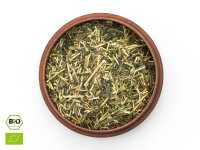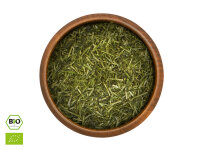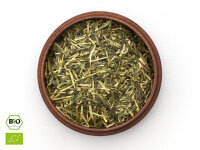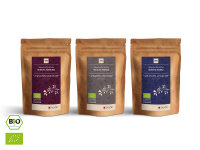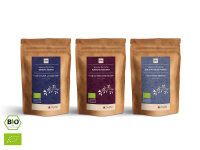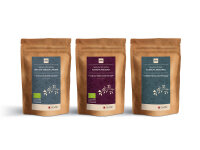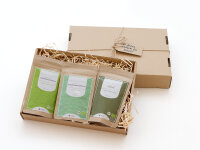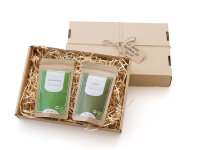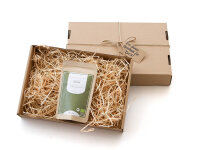
Kukicha Tea
Kukicha Karigane – The Special Stem Tea from Japan
The name Kukicha essentially means "stems, stalks" (Kuki) and tea (cha). Kukicha is, in essence, a tea made from the stems of tea leaves. For this Japanese green tea variety, parts from Sencha, Gyokuro, or Bancha are used. In the Kyushu region, it's also known as "Shira-ori-cha," and in Kyoto, it's called "Karigane." Throughout Japan, it's commonly referred to as "Kukicha." For high-quality versions, only the stems from premium organic Sencha and Gyokuro are used.
In general, Kukicha is made from tea stems and leaves that are either too large or too small and were sorted out for aesthetic reasons during the selection process for the mother tea. In other words, during the processing of Sencha and Gyokuro, the leaves, stems, and buds are separated from the raw tea used to make Sencha and Gyokuro. The leaves are used to create loose Sencha and Gyokuro tea products, while the stems are used to make Kukicha. The buds and broken leaves are used for other tea products. It's remarkable that no part of a tea leaf goes to waste, and every part of a tea leaf is used to produce various Japanese green tea varieties! So, when the raw tea is of high quality, such as for making high-quality Sencha or Gyokuro, the stems sorted out from this raw tea are also of high quality.
Kukicha has low astringency and is rich in umami and sweetness, as these elements are mainly found in the stems of the tea leaves. Tea stems, which are not exposed to direct sunlight (as they are covered by tea leaves), contain a large amount of theanine, an amino acid in tea that imparts a sweet taste to the tea. Additionally, it has a unique refreshing aroma and is characterized by a transparent light green color. The price of high-quality Kukicha is relatively affordable compared to high-quality Sencha or Gyokuro. All of these qualities make it a popular tea in Japan.
The tea's processing is done with the same care as with other green teas, as only after gentle steaming, rolling of the leaves, and drying are the green teas sorted. The flavor is a slightly milder, slightly nutty variation of the mother tea with surprisingly full, slightly sweet aromas. Therefore, very high-quality Kukicha is often called "Gyokuro for the less affluent." Our Kukicha Kaede is based on pure Gyokuro and the Kukichu Hatsukoi is also made from components of organic Sencha and Gyokuro.
Kukicha Karigane in Organic Quality at ORYOKI
This tea is truly an interesting green tea. Especially the premium version (often referred to as Karigane) has piqued our interest. And we can only emphasize that this green tea rightfully earns a place among the top teas. The philosophy of not wasting any valuable tea harvest appeals to us just as much. Depending on the tea type, the top qualities are then called Sencha Karigane, Bancha Karigane, or Gyokuro Karigane. With Kukicha Kaede, we have a Gyokuro Karigane with high proportions of tea leaves in our assortment that you should definitely compare with Gyokuro.
The Right Time for Enjoying Green Tea
Because the caffeine content in this tea is extremely low, it is often enjoyed in the evening in Japan.
Currently, we are testing additional selected green tea varieties from Japan, some of which will soon be added to our green tea selection.
The "Proper" Preparation of Kukicha
The preparation of Kukicha is also influenced by the base green tea. In general, very high-quality tea is prepared at a lower temperature. Therefore, Kukicha based on Gyokuro should be prepared at around 55°C to 60°C. The price of the tea can indeed provide valuable guidance for assessing its quality. Less expensive teas are prepared with water at around 70°C to 80°C. The steeping time varies between one to two minutes.

